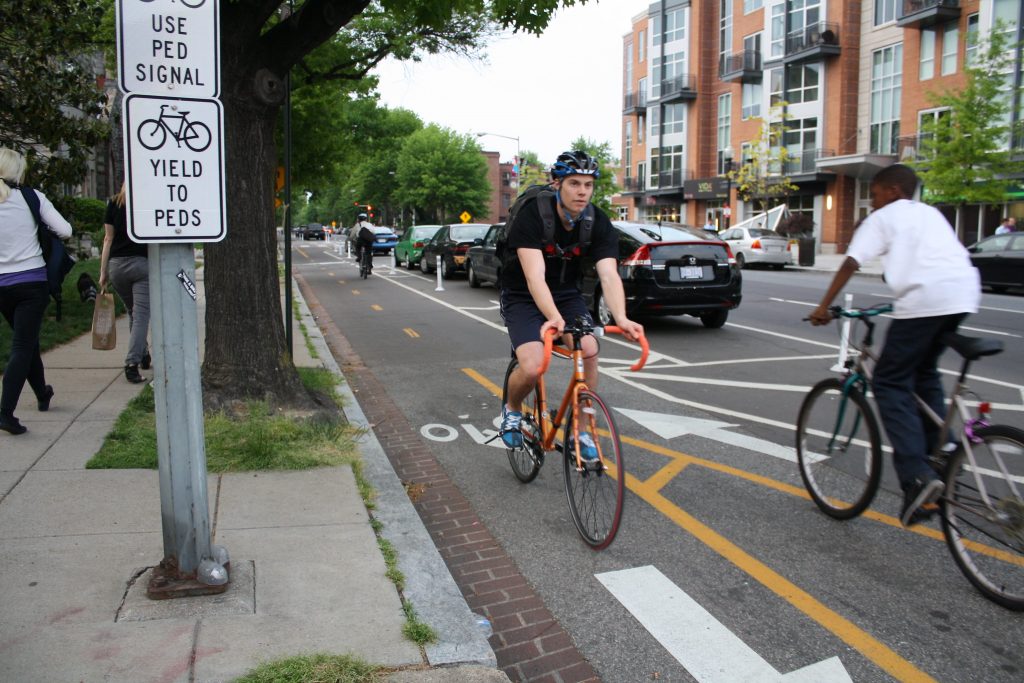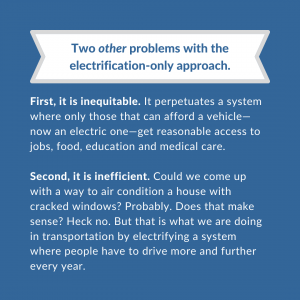Why the Senate’s transportation bill is terrible for climate
Last summer, the Senate Environment and Public Works Committee passed a long-term transportation bill that was praised for its climate title, marking the first time the word “climate” was included in a bipartisan transportation bill. But while this climate title was worth celebrating, the bill overall would actually result in more emissions, not less. Here’s how, and why we need a different approach.
Check out the recap of our webinar with Third Way, where we discussed why the Senate’s bill is bad for climate, why the House’s INVEST Act is much better, and what advocates can do to help Senators improve their next transportation bill.

A protected bike lane in Washington, DC. Photo by Elvert Barnes on Flickr’s Creative Commons.
Last July, the Senate Environment and Public Works (EPW) Committee passed the America’s Transportation Infrastructure Act (ATIA), this committee’s stab at reauthorizing transportation policy once the existing law expires this September. Amid the status quo of more money for existing federal transportation programs, the bill would spend $10 billion over five years on a new suite of climate and carbon reduction programs, including funds to incentivize states to develop and adopt carbon reduction strategies and grants for electric vehicle charging infrastructure. But this $10 billion for climate will fail to accomplish much when the rest of the bill funnels $277 billion into traditional programs that are perfectly designed to increase emissions.
Here’s how—and how the House’s recently-passed bill will actually shift the climate paradigm.
To reduce emissions, we need to allow people to drive less
Transportation accounts for the largest share of carbon emissions in the U.S., and those emissions are rising—even as other sectors have improved. This is because vehicle miles traveled (VMT) is increasing, negating the 35 percent increase in the overall fuel efficiency of vehicles on our roads between 1990-2016. Carbon emissions rose by 21 percent over that period because VMT rose by 50 percent.
 We won’t be able to increase fuel efficiency and electrify cars faster than VMT is rising, reducing the impact of electrification particularly in the next 10-20 years. And VMT is rising because the current federal transportation program—the broken program that the Senate is proposing to effectively renew with more money for five years—increases driving by design. U.S. transportation policy is focused on building more and wider highways instead of maintaining what we have, and without making sure that those new highways actually improve people’s access to the places they need to reach. This divides communities by the highway from the things they need across the highway and pushes development (and the people who live there) further away from the things they need, making them drive further and further just to get where they need to go on a daily basis.
We won’t be able to increase fuel efficiency and electrify cars faster than VMT is rising, reducing the impact of electrification particularly in the next 10-20 years. And VMT is rising because the current federal transportation program—the broken program that the Senate is proposing to effectively renew with more money for five years—increases driving by design. U.S. transportation policy is focused on building more and wider highways instead of maintaining what we have, and without making sure that those new highways actually improve people’s access to the places they need to reach. This divides communities by the highway from the things they need across the highway and pushes development (and the people who live there) further away from the things they need, making them drive further and further just to get where they need to go on a daily basis.
The bill passed in the House is much better for climate
If we want to reduce transportation emissions, we must reform the programs at the heart of federal transportation policy that allow and even encourage states to build new roads and expand existing ones in a way that divides communities and pushes development further out. The Senate bill’s $10 billion for climate doesn’t stand a chance against the unchanged status quo, but the bill recently passed by the House of Representatives—the INVEST Act—is a step in the right direction.
For one, the INVEST Act requires that states maintain roads before building new ones. This is a huge step toward reducing unwise road building and expansion that often cuts off short local trips making people drive more, displaces existing communities (more often people of color) and encourages more development far from everything those residents will need to get to. That is the status quo maintained by the ATIA: increasing VMT, the backlog of maintenance needs, and congestion.
While the Senate created an Accessibility Data Pilot Program in the ATIA, the House took that up a notch by creating a performance measure that requires states and metropolitan planning organizations (MPOs) to improve access to jobs and services by all modes. This means that project sponsors must determine whether people traveling (not just driving) can reach jobs, schools, groceries, medical care and other necessities.
Under the INVEST Act’s performance measure, states and MPOs will be penalized if they fail to use federal funding to improve that access—effectively incentivizing project sponsors to not build new or expanded roads. New roads don’t help nondrivers and they don’t help drivers get where they need to go any faster if they have to travel further, which is often the result of these projects.
In another major shift, the INVEST Act also requires that states measure and reduce greenhouse gas emissions from their transportation system. States that reduce emissions can be rewarded with increased flexibility on how they spend federal dollars, while states that fail to reduce emissions will face penalties, as we wrote in this blog with our partners at Third Way.
These aren’t the only ways the House has taken a far superior, holistic approach to the Senate on climate. While not perfect, the INVEST Act makes significant progress towards electrifying our vehicle fleet, increasing transit funding, and making biking and walking safer (read more about these policies here).
The Senate’s bill doesn’t go far enough
One thing is certain: the Senate doesn’t go nearly far enough. To be clear, we understand that the climate champions do not have the numbers to overcome the climate deniers in the Senate and that getting any climate language in their bill took real work. Kudos to those that fought for these programs. However, there should be an understanding from real climate champions about its weakness and how little it does to attack the underlying climate problems with our approach to transportation in this country.
These champions might tout the climate provisions they got but vote against the bill, which happens all of the time. Or they could vote for the bill while being open about the continuing problems caused by the 96.7 percent of the funding that does nothing to address climate, much of which will harm our efforts to stave off catastrophic climate change. Or if not those options, they could loudly praise the superior House bill and welcome those ideas to the conversation in conference. And to be clear, this isn’t just an issue with those seeking to address climate in the Senate but also to those stakeholders that work on the issue from across the country, who praised this bill as if it made real change and didn’t just give a tiny portion of funding to fix the problem that is continuing to be generated by 30 times the funding given to climate.
It is too late for this meek approach. We all must do more. It’s time for bold action, not just an add-on to the status quo.
Bipartisan, climate-forward transportation legislation is possible—but only if lawmakers rethink what transportation investments can achieve. Check out our director Beth Osborne’s take on why bipartisanship on its own can’t make a transportation bill great.




















3 Comments